Monster Plank Revisited
I have gotten a lot of emails about what to do with the 16/4 wide African Mahogany plank I showed in a recent episode. I have been reserving judgement until I could get a better look at the board and see it’s character as well as how it works. African Mahogany has many species variants and their working properties are all over the place based on region, soil content, climate, and drying techniques among other things. From a hand tool perspective, the Khaya genus that African Mahoganies fall into is tough to work. The interlocking grain causes tear out when planing and the extra hardness of 1370 is a third again harder than Genuine Mahogany. In other words I tread carefully when I run across the stuff. However, some of the species are really very nice. Khaya ivorensis is one of the more agreeable species in that it has consistent grain and good density. 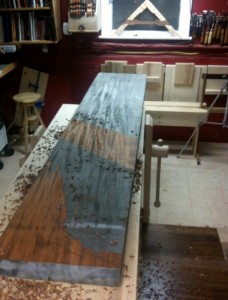 The interlocked grain makes for extra work with a hand plane, but it can be cleaned up.
The interlocked grain makes for extra work with a hand plane, but it can be cleaned up.
Last week, I used this monster plank in a live lesson on The Hand Tool School to demonstrate how to surface a wide and long board entirely by hand. First let me say that this live lesson experience was one of my favorite moments since I took up the blogging/podcasting mantle. It is nerve wracking doing something live like this, but the chat room was engaged and the wood was beautiful so it was a great time. It is truly what I envisioned when I formed the Hand Tool School so thank you to my members who came out armed with questions.
The plank came out beautifully and the ribbon stripe is much more pronounced than I thought it would be. 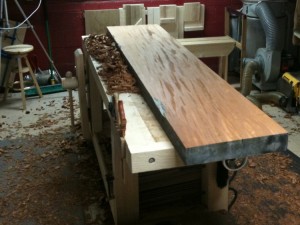 I actually spent some time double checking to make sure I didn’t have some Utile or low figure Sapele on my bench because the ribbon was so intense. It is indeed an African Mahogany by the way. In working the wood I encountered some to be expected tear out with these bands of end grain that make it so pretty. Here you can see the surface after initial flattening with a Fore plane and an aggressive cut.
I actually spent some time double checking to make sure I didn’t have some Utile or low figure Sapele on my bench because the ribbon was so intense. It is indeed an African Mahogany by the way. In working the wood I encountered some to be expected tear out with these bands of end grain that make it so pretty. Here you can see the surface after initial flattening with a Fore plane and an aggressive cut.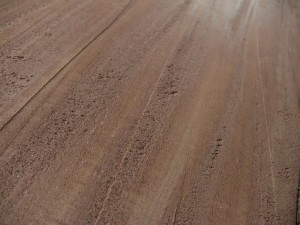
Once I had completed several passes with the Jointer plane then moved on to spot smooth the surface I was left with a glistening planed surface that would make any drum sander blush. I won’t lie, it was a lot of work and I was completely beat by the end of the night. 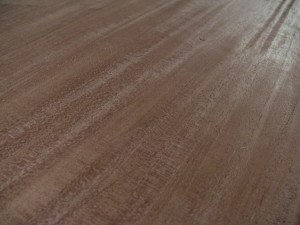 I can be truly proud that this board was surface entirely by my own two hands and I now know this board much more intimately than if I had fed it through the thickness planer. (Of course I would need to buy a new, wider thickness planer to do that)
I can be truly proud that this board was surface entirely by my own two hands and I now know this board much more intimately than if I had fed it through the thickness planer. (Of course I would need to buy a new, wider thickness planer to do that)
Now know where the especially difficult grain is as well as the exceptional figure. I find that armed with this knowledge I am well suited to piece together a project from the board.
The plan right now is to use a small amount of a highly figured section on the end of the board as veneered drawer fronts and door panels in my upcoming tool cabinet project in the Hand Tool School. The rest of the plank is unreserved. 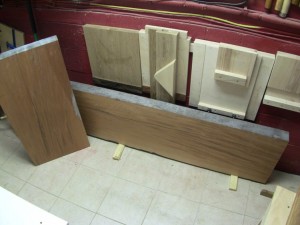 I cannot imagine efficiently using the full length of this plank in any furniture piece so I decided to saw it up last night so that I could store it a little easier. Keeping in mind future projects, I sawed off a 32″ length knowing that with the 16/4 thickness I could make some beefy cabriole legs for a card table design I have had my eye on for some time. The remaining 67″ will make a single board top with drop leaves, and if properly resawn, it could be several tops and aprons. Maybe I’m nuts, but I think the challenge of resawing a 19″ wide board will be fun.
I cannot imagine efficiently using the full length of this plank in any furniture piece so I decided to saw it up last night so that I could store it a little easier. Keeping in mind future projects, I sawed off a 32″ length knowing that with the 16/4 thickness I could make some beefy cabriole legs for a card table design I have had my eye on for some time. The remaining 67″ will make a single board top with drop leaves, and if properly resawn, it could be several tops and aprons. Maybe I’m nuts, but I think the challenge of resawing a 19″ wide board will be fun.
For now I have 2 tables planned and I should be able to get all of the lumber from this single board! There will be no need to worry about color and grain match here. I will probably break down this stock further, closer to furniture parts to release tension and allow some more moisture to escape so you all will see more of this board in the future.


